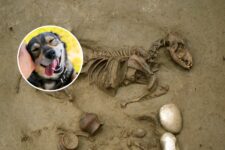
Ancient Animal Lovers Found Buried Alongside Their Dogs
The bond between pet and owner may have been as strong as it is now for centuries, with some ancient humans being buried with their animal companions more than 2,000 years ago, archaeologists have discovered.
The remains of 161 people from Italy between the third and first century B.C.E. were analyzed by archaeologists, and they found that 16 of the people were accompanied by some form of animal remains.
The animals found alongside people at an archaeological site in Verona, named Seminario Vescovile, included pigs, chickens and cows, which may have been part of food offerings, but others were found next to dog and horse remains, according to a new paper in the journal PLOS ONE.

Laffranchi et al., 2024 / S.R. Thompson, courtesy of SABAP-VR Soprintendenza archeologia, belle arti e paesaggio per le province di Verona, Rovigo e Vicenza.
Dogs and horses weren’t commonly eaten by people in the area at this time, indicating that they could even have been pets or important animals in a person’s life and were buried alongside their owners.
“This context, culturally attributed to the Cenomane culture, features 161 inhumations, of which only 16 included animal remains in the form of full skeletons, isolated skeletal parts, or food offerings. Of these, four are of particular interest as they contain either horses (Equus caballus) or dogs (Canis lupus familiaris)–animals that did not play a dietary role,” the authors wrote in the paper.
One skeleton was that of a baby, who was found buried alongside a complete dog skeleton, while others included a young man with parts of a horse, a middle-aged man with a small dog, and a middle-aged woman alongside a whole horse, a dog skull, and parts from other horses.
The researchers analyzed the genetics of both the humans and animals discovered in the graves, and investigated the diets and burial conditions of the remains. They found that there was no significant correlation between the people who had been buried alongside animals. This implies that the people were not related, and therefore not part of a single family.
This lack of pattern means that there are many possible interpretations of why these people were buried with animals, ranging from religious symbolism to animal companionship.
Horses and dogs have been found buried alongside humans throughout history, though the significance of these funerary rites is likely very different from culture to culture.
“Turning to dogs, their appearance in human burials is archaeologically documented from at least the late Paleolithic, the earliest evidence of this custom being that of Born-Oberkassel (Germany, 12290–12050 cal. B.C.E.).
“The appearance of dogs in funerary contexts, associated with human graves or not, presents a remarkable geographic distribution, with finds identified in Eurasia and the Americas and a chronological extension spanning from the Paleolithic to contemporary times,” the authors wrote in the paper.
Unfortunately for the dogs found in these Verona graves, it appears likely that they were sacrificed for the burial, possibly to symbolize passing into the afterlife.
“In particular, it is tempting to cautiously postulate an association between the deposition of this animal and their association to the underworld. A link between dogs and the afterlife can be found throughout time and space, with examples from ancient Egypt, Scandinavia, classical, and Gallo-Roman culture,” the authors wrote.
However, the authors note that there may be many cultural variables coming into play regarding the reasons these animals were buried with humans, including the status of the person in the society of the time and specific funeral rites of the community.
“What we observe is only a fraction of the material aspects of the ritual. In addition to the inevitable loss of information due to the degradation of organic materials, the observed remnants provide only approximations, lacking crucial components of ritualistic performances like sensorial and gestural elements.
“Second, funerary rituals are communal representations enacted by the surviving community members, shaped by their shared needs and symbolic codes,” the researchers wrote in the paper.
“Accordingly, interpretations of burials, including those from [Seminario Vescovile], need to take into account their link to the deceased social persona and biography as well as how the survivors mediated, interpreted, and potentially imbued additional meanings into the death and circumstances surrounding it.”
Therefore, while these animals may have been pets, it’s impossible to truly know the reason why they were buried alongside humans over 2,000 years ago.
Do you have a tip on a science story that Newsweek should be covering? Do you have a question about ancient humans? Let us know via science@newsweek.com.




